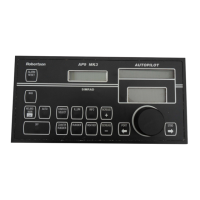Robertson AP9 MK3 Autopilot
2-16 20169223D
last update and the amount of course change. If a change of more
than 10 degrees is commanded, the alarm will sound and the
ALARM RESET button has to be pressed to acknowledge the course
change. The plain CTS mode is rarely used today after the GPS has
replaced the Transit system.
For receivers with NMEA 0183 format that outputs both the cross
track error (XTE) and bearing waypoint-waypoint (BWW), e.g. an
APB sentence, the autopilot can operate in the priority mode (also
called mixed mode) utilizing both signals.
Note ! The Course Change knob and buttons are disabled when operating the
autopilot in NAV. mode.
Steering by XTE to waypoint
When the autopilot is using XTE, the set course is automatically
adjusted in order to keep the vessel on a straight track between two
waypoints. Satisfactory steering depends upon good reception
conditions and correct adjustment of the autopilot.
During poor reception conditions, the receiver transmits an alarm
warning which activates the alarm circuit in the autopilot. The set
course reference is not updated until the reception conditions
improve. See Fault Warnings on page 2-25.
Make the following check before using navigational steering:
1. Set the Nav. receiver to calculate the bearing from present position
to a waypoint.
2. Steer the vessel by hand on the calculated bearing and select
AUTOPILOT-mode.
3. Let the autopilot steer the vessel for a period of about 2 minutes to
settle on the new course.
4. Make a starboard course change of 5°, by pushing 5 times on
STBD button and check that a course track error is built up on the
navigation receiver showing that the vessel is located to the right
of the bearing line.
5. Repeat step 4 with a 10° course change to port and check that the
vessel moves to the opposite side of the bearing line.
When the autopilot is performing satisfactorily in AUTO-mode, use
the following procedure:
1. Enter the desired bearing line(s) to the Nav. receiver using the
present position and the first waypoint or destination. Distance
between waypoints should be of minimum 1 n.m. Otherwise there
may not be sufficient time for the system to calculate the XTE, and
for the autopilot to alter the course and bring the vessel onto the
bearing line again.

